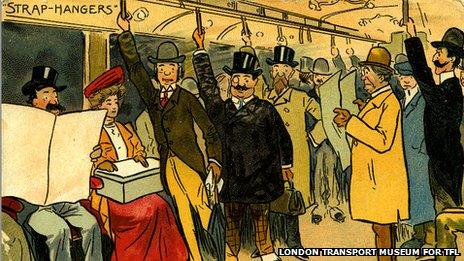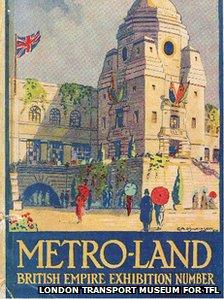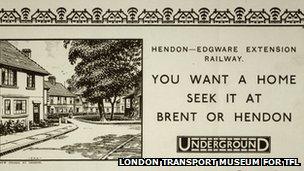Tube 150th anniversary: Exploiting the 'suburban dream'
- Published

The railway has been credited with helping to create London's suburbs
London's urban landscape has changed dramatically since the Metropolitan Railway, the first underground railway in the world, opened in 1863.
Built as a 3.5 mile (5.6km) line linking Paddington, Euston and King's Cross with the central London business district, its reach would eventually extend through north-west London and into Buckinghamshire.
Today, half of Londoners are said to live in the suburbs.
"Public transport helped create the capital's suburbs and influences where people live," said Martin Harrison-Putnam, head of collections at the London Transport Museum.
"The Underground influenced and exploited the suburban dream of a house and garden, fresh air and a convenient journey."
The Metropolitan Railway saw housing development as a way of boosting its income long-term, and the Metropolitan Surplus Lands Committee was formed in 1887 to manage surplus land it had bought to build its railway lines.
The company's first housing estate was built in Pinner in 1900, and the railway set up a publicity department to promote its new developments through leaflets and literature.
The department's copywriter James Garland coined the name Metro-Land in 1915.
Estates were built in north-west London, Middlesex, Hertfordshire and Buckinghamshire in areas including Wembley, Neasden, Eastcote, Rayners Lane, Ruislip, Rickmansworth and Amersham.
Thousands of homes were built in Metro-Land during the 1920s and 1930s, leading to a huge rise in the demand for season tickets.
Mortgages were also becoming more available and appealing to the middle classes in the 1930s.
Many of Metro-Land's residents had previously been living in multi-occupancy houses and dreamed of having a modern home with more space.
The suburban community was immortalised by Poet Laureate John Betjeman in a BBC documentary in 1973, which saw him travel from Baker Street to Amersham, celebrating the suburbs along the way.
'More profit'
The London Transport Museum said that between 1923 and 1928, monthly season ticket sales at Wembley Park rose from 3,000 to 13,500.
The line expanded to Watford in 1926, Stanmore in 1932 and later into Buckinghamshire, while the Metropolitan District Railway, now the district line, expanded south.
Estate agents began building offices next to the stations.
In the early 20th century the railway helped create the London suburbs
Mr Harrison-Putnam said the personalities involved at the time were one of the factors that led to growth in the railway in the west and the north-west of London.
A bitter rivalry developed between between Sir Edward Watkin, chairman of the Metropolitan Railway, and James Staats Forbes, who chaired the Metropolitan District Railway.
The pair had different visions, with Watkin, who wanted to build a Channel tunnel rail link to France, seeing the Metropolitan as a mainline railway, while Forbes preferred shorter extensions.
Mr Harrison-Putnam said: "There was basically more profit in longer journeys, season tickets and the additional benefits of freight and through running agreements with other railways, than there was in providing intensive urban services.
"The growth of the Victorian suburbs and, especially for the Metropolitan Railway, the parallel profitability of goods traffic, were a spur for raising money for the extensions."
Suburbia continued to expand when the Hampstead tube extended to Golders Green, then part of the countryside, in 1907 in a move to stimulate suburban development in accordance with an American model.
Chicago-born financier Charles Tyson Yerkes, who bought various railways in London between 1900 and 1902, built Golders Green station in 1907, boasting that if he built people would come.
'Garden suburb'
The Charing Cross, Euston and Hampstead Railway, now the Northern Line, brought an 800% rise in land prices at Golders Green, Mr Harrison-Putnam said.
Hendon Central Station opened as an extension from Golders Green in 1923, and extended to Edgware the following year.

Metro-Land was immortalised by Poet Laureate John Betjeman
By 1933, the Great Northern, Piccadilly and Brompton Railway had extended to reach Uxbridge in north-west London, Hounslow in west London, and Cockfosters in north-east London.
The Central line extended to Loughton in the east and West Ruislip in the west between 1946 and 1949.
The Garden City movement also played a part in suburban development.
The Bedford Park Society said that Bedford Park, near Turnham Green station in west London, was the world's first garden suburb, and the inspiration for the garden cities that followed.
Built between 1875 and 1886, it had a church, parish hall, shops and a pub.
In 1898 Ebenezer Howard, dubbed the founder of the Garden City movement, outlined his vision of communities that combined the best aspects of town and country living in the book Tomorrow, A Peaceful Path to Real Reform, later republished as Garden Cities of Tomorrow.
Each garden city would have its own green belt, and the developments would adhere to planning rules such as road width and house size.
The first such garden city was built at Letchworth in Hertfordshire in 1903.
Hampstead Garden suburb was founded in north London by social reformer Henrietta Barnett in 1907.
When Dame Barnett heard news of the construction of the Hampstead line and station, she immediately organised a committee to save 80 acres of land from "rows of ugly villas".
The principles behind Hampstead Garden suburb included that all classes and the disabled would be welcomed, that plots should be divided by hedges or fences rather than walls, and that every road should be lined with trees.

Hendon Central Station opened in 1923 and the line was extended to Edgware the following year
Now home to about 13,000 people, Hampstead Garden Suburb became a designated conservation area in 1967.
A spokesman from Barnet Council, the local authority, said it was now "internationally recognised as one of the finest examples of early 20th Century domestic architecture and town planning".
Mike Brown, managing director of London Underground and London Rail, said: "At a time when people had no electricity in their homes, inside toilets were a rarity and radio and television did not yet exist the Tube was a revolutionary blast of modernism.
"The building and extension of the Underground directly led to new towns and villages becoming part of the capital, supporting the development of the suburbs and the transformation of the Docklands.
"It is the Tube which has allowed people to easily work in a different place from where they live - linking businesses, families and communities in a way that was hitherto unimaginable.
"The Tube lines have become the arteries and veins that pump life around our city."
